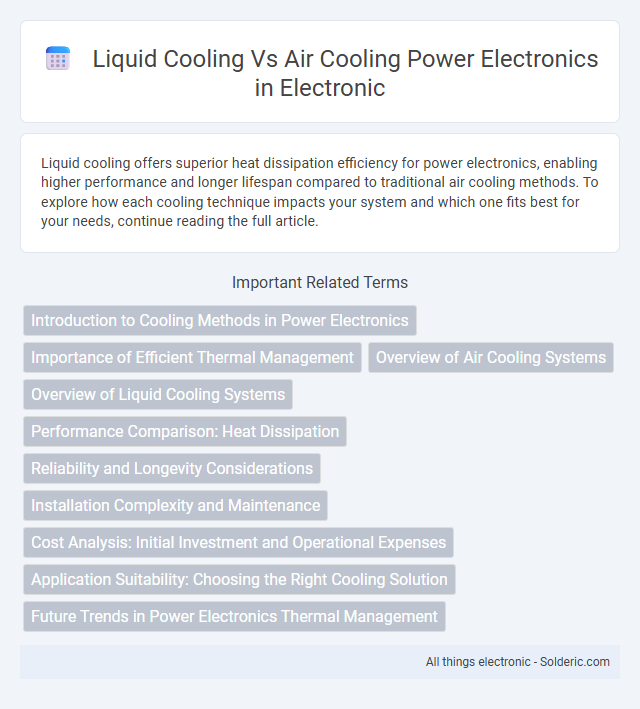Liquid cooling offers superior heat dissipation efficiency for power electronics, enabling higher performance and longer lifespan compared to traditional air cooling methods. To explore how each cooling technique impacts your system and which one fits best for your needs, continue reading the full article.
Comparison Table
| Feature | Liquid Cooling | Air Cooling |
|---|---|---|
| Cooling Efficiency | High thermal conductivity, superior heat dissipation | Moderate, relies on convection and airflow |
| System Complexity | Complex setup with pumps and coolant | Simple design, fans and heat sinks |
| Cost | Higher initial and maintenance cost | Lower upfront and maintenance expense |
| Size and Weight | Compact but requires coolant reservoirs | Bulkier due to large heat sinks |
| Reliability | Potential leaks; requires regular checks | Less risk of failure, more robust |
| Noise Level | Low noise operation | Higher noise due to fans |
| Application Examples | High-power density electronics, EV inverters | Consumer electronics, general power devices |
Introduction to Cooling Methods in Power Electronics
Liquid cooling in power electronics offers superior thermal management by efficiently transferring heat away from high-power components, maintaining optimal operating temperatures. Air cooling relies on airflow and heat sinks to dissipate heat but may struggle with heat density in compact or high-performance systems. Your choice between liquid and air cooling impacts device reliability, efficiency, and lifespan in power electronics applications.
Importance of Efficient Thermal Management
Efficient thermal management in power electronics is crucial to maintain device reliability and prevent overheating, which can lead to premature failure and performance degradation. Liquid cooling systems offer superior heat dissipation capabilities compared to air cooling by utilizing high thermal conductivity fluids that rapidly remove heat from critical components. Optimizing thermal management extends the lifespan of power electronics, enhances operational efficiency, and supports higher power densities in modern industrial applications.
Overview of Air Cooling Systems
Air cooling systems in power electronics use ambient air to dissipate heat through heat sinks, fans, or blowers, offering a cost-effective and simple thermal management solution. These systems rely on natural or forced convection to maintain device temperatures within safe operating limits, making them ideal for less thermally demanding applications. However, air coolers often face limitations in high-power density environments where liquid cooling's higher heat transfer efficiency becomes essential.
Overview of Liquid Cooling Systems
Liquid cooling systems in power electronics utilize a liquid coolant, typically water or a glycol mixture, to absorb and dissipate heat more efficiently than air cooling. These systems incorporate components such as pumps, heat exchangers, and cold plates that directly contact heat-generating devices, enabling higher power density and improved thermal management. Liquid cooling is essential for applications requiring compact design and enhanced reliability under high thermal loads.
Performance Comparison: Heat Dissipation
Liquid cooling offers superior heat dissipation compared to air cooling, enabling power electronics to maintain lower operating temperatures under high thermal loads. This enhanced thermal management results in improved performance stability and prolonged device lifespan, especially in applications with dense power components. Optimizing your system with liquid cooling can significantly reduce the risk of overheating and thermal throttling.
Reliability and Longevity Considerations
Liquid cooling offers superior thermal management for power electronics by efficiently dissipating heat, which enhances reliability and extends component lifespan compared to air cooling. Air cooling relies on airflow and ambient conditions, making it less effective under high thermal loads and prone to overheating, potentially reducing the longevity of your power electronics. Optimizing cooling methods based on operational demands is critical to maintaining system performance and preventing premature failures.
Installation Complexity and Maintenance
Liquid cooling systems for power electronics typically involve more complex installation processes due to the need for pumps, tubing, and coolant reservoirs, increasing setup time and technical requirements. Maintenance demands are also higher, as you must monitor coolant levels, check for leaks, and periodically flush the system to prevent blockages or corrosion. Air cooling, by contrast, offers simpler installation with passive or fan-based heat dissipation and lower maintenance needs, making it suitable for applications prioritizing ease of use and reliability.
Cost Analysis: Initial Investment and Operational Expenses
Liquid cooling systems for power electronics often require a higher initial investment due to specialized components like pumps, heat exchangers, and coolant fluids, compared to air cooling solutions that primarily rely on fans and heat sinks with lower upfront costs. Operational expenses tend to be lower for liquid cooling in high-performance or high-density power electronics because of superior thermal efficiency leading to reduced energy consumption and longer component lifespan. Your choice should consider the total cost of ownership, balancing initial expenses against potential savings in maintenance and energy efficiency over time.
Application Suitability: Choosing the Right Cooling Solution
Liquid cooling offers superior thermal management for high-power electronics in applications requiring compact designs and continuous heavy loads, such as electric vehicles and data centers. Air cooling suits lower power scenarios or environments where system simplicity and lower maintenance costs are prioritized, like consumer electronics or light industrial equipment. Your choice should consider factors like heat dissipation needs, space constraints, and operational reliability to ensure optimal performance and longevity.
Future Trends in Power Electronics Thermal Management
Future trends in power electronics thermal management highlight the growing adoption of liquid cooling due to its superior heat dissipation capabilities and compact design advantages. Advanced dielectric liquids and microchannel liquid cooling systems are being developed to address the increasing power density and efficiency demands in electric vehicles and renewable energy converters. Innovations in hybrid cooling methods combining liquid and air cooling are also emerging to optimize thermal performance while reducing system complexity and cost.
Liquid Cooling vs Air Cooling Power Electronics Infographic

 solderic.com
solderic.com